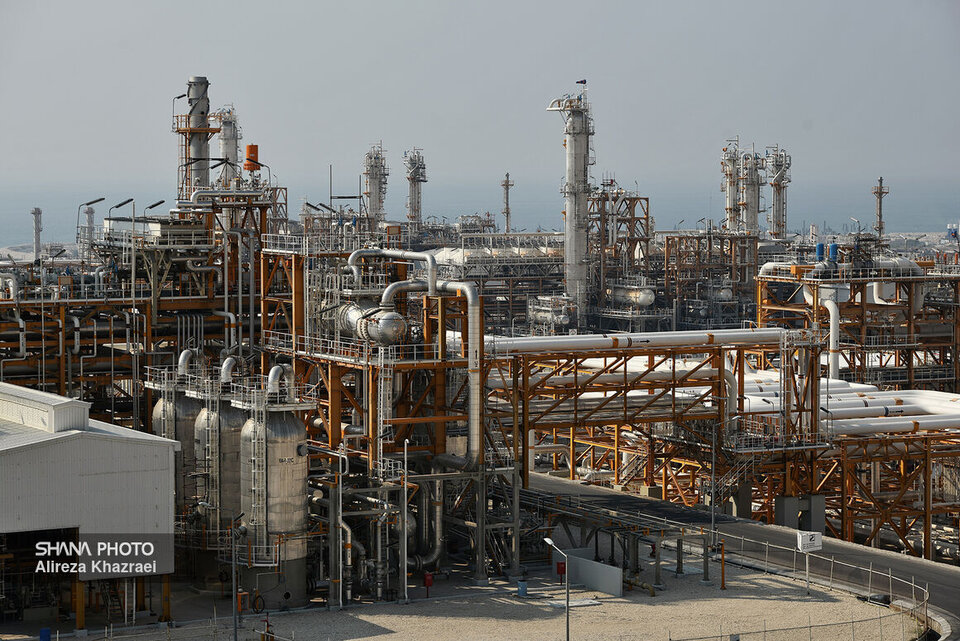Touraj Dehqani, CEO of Pars Oil and Gas Co. (POGC), said the fire was immediately contained by firefighting team there. Thanks to relentless efforts made by service workers there, the damaged unit of the refinery was back online on June 26.
70% Supply Share
Iran enjoys a privileged position in the gas sector. One of the main gas resources in the world, i.e. South Pars gas field, lies in Iran. South Pars Gas Complex (SPGC) is a big company supplying refined gas and other products in Iran. It accounts for 70% of national gas supply. It took about 14 years to build the SP14 refinery that came on-stream in March 2023. At the peak of work on this megaproject, about 9,000 persons were involved, who were forecast to reach 100,000. That is why Dehqani explains South Pars as the integrated asset of Iranians. He said that South Pars gas is instrumental in supplying energy needs of industries, power plants and households. It makes the biggest contribution to Gross Domestic Product (GDP).
SPGC produces 56.6 mcm/d of rich gas, 75,000 b/d, 1.05 mt/y of LPG (propane and butane), 1 mt/y of ethane to feed petrochemical plants and 400 tonnes a day of sulfur.
Located 105 km of Kangan, the refinery has 4 offshore platforms, 44 wells, two offshore gas pipelines 105 km each and two offshore glycol pipes 105 km each.
Overhaul Meetings
The strike on the South Pars refinery came about one month after Ali Reza Sarmadi, POGC director of production and operations, had announced the end of overhaul of platforms of SP14.
Dehqani said meetings by the Directorate of Crisis Management and Civil Defense of POGC were held regularly in Bushehr Province in coordination with the POGC head office in Tehran since the very beginning of the 12-day war.
“In the meetings held aimed at reaching maximum readiness to encounter possible threats and emergency conditions, all necessary arrangements were made to protect the health of staff, ensure safety of installations, guarantee maximum gas recovery from South Pars and carry out the annual overhaul of offshore platforms,” he said.
Rapid Recovery
The accident caused by the Zionist regime’s strike on the SP14 refinery was contained and repaired rapidly to allow for sustainable gas supply by South Pars under critical conditions.
During the tumultuous days when one might think that the South Pars refinery would suffer serious damage, the head of POGC announced that the damaged unit was resumed production.
Since the very first hours of attacks, Dehqani was present in Kangan and Assaluyeh to issue necessary instructions to accelerate decision-makings and conducting technical and safety measures.
“The accident was controlled immediately thanks to efforts made by safety and firefighting teams and service workers. Necessary arrangements were made and SP14’s gas feeding into national trunkline resumed,” he said.
Most Iranian Refinery
One of the outstanding features of the SP14 refinery is its local nature. It has been entirely constructed by Iranian work force and even 70% of equipment used at this facility is domestically manufactured. That is why it is known as the most Iranian refinery. It might have given impetus to enemies to strike the main artery of the petroleum industry to bring a halt to national energy supply. However, the conspiracy failed.
Such empathy and cooperation drew praise from Dehqani. Referring to the steadfastness of Iranian nation against enemy invasion and the Armed Forces’ bravery, he said: “I feel compelled to extend my gratitude to POGC staff, particularly service workers on South Pars platforms that did their best in guaranteeing the flow of gas. Maximum endeavor by POGC staff during war conditions continued, presenting a brilliant image of national solidarity.”
Young Civilization
South Pars is not merely a structure or a name to vanish easily. It is a three-decade-old civilization rooted in the Iranian history. It owes its life to Iranian experts. South Pars will be recognized as a turning point in Iran’s petroleum industry. As historical evidence shows oil extraction dates from the Achaemenid period, specifically around Susa, we may consider the South Pars gas field as a young offspring of Iran.


Your Comment